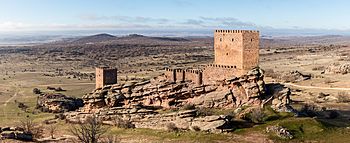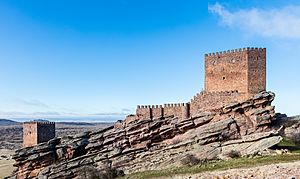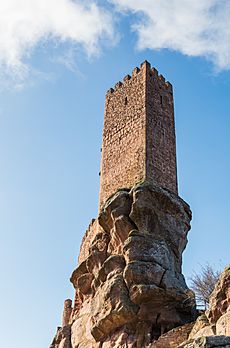Castle of Zafra (Guadalajara) facts for kids
Quick facts for kids Castle Of Zafra |
|
|---|---|
| Campillo de Dueñas, Spain | |

Exterior view of the Castle of Zafra
|
|
| Coordinates | 40°50′05″N 01°42′23″W / 40.83472°N 1.70639°W |
| Type | Fortification |
| Site information | |
| Owner | Private |
| Condition | Partly restored, otherwise ruined |
| Site history | |
| Built | Late 12th or early 13th century |
| Built by | Kingdom of Aragon |
| In use | 12th or 13th – 16th centuries |
| Materials | Sandstone |
The Castle of Zafra (Spanish: Castillo de Zafra) is an old castle from the 12th century. You can find it in Campillo de Dueñas, a town in Guadalajara, Spain. It was built in the late 1100s or early 1200s on a rocky hill. This spot was once home to older forts built by the Visigoths and later by the Moors.
The castle was very important because it was almost impossible to attack. It stood on the border between Christian and Muslim lands in Spain. The Castle of Zafra was never captured by enemies. It was successfully defended even against the King of Castile in the 1200s. After the Reconquista (when Christian kingdoms took back Spain) ended in the late 1400s, the castle was no longer needed for wars. It slowly fell apart over the centuries. However, since 1971, its private owners have been working to restore it. You can visit the castle if you get permission from the owners.
Contents
What Does "Zafra" Mean?
The name of the castle, Zafra, comes from an Arabic word. In Spanish-speaking countries, zafra means the harvest season in late summer or early autumn. This is especially true for crops like sugarcane, which came from Arab lands. Some people think the word comes from the Arabic zāfar or zafariya, meaning "harvest time". Others believe it comes from saʼifah, which means "gathering time".
Exploring the Castle of Zafra
The Castle of Zafra sits on a large rock. This rock is about 1,400 metres (4,600 ft) high in the Sierra de Caldereros mountains. The area around it has grassy fields and rocky hills. The castle covers the entire top of its rocky hill. A strong wall surrounds the top of the hill. This wall connects the entrance tower at one end to the main buildings at the other. You can still see signs of other buildings around the castle. These might have been stables or storage areas.
Inside the castle walls, there are four main parts. At the far end is the entrance tower. After that, you enter an open courtyard. This leads to the Place of Arms, where soldiers would gather. This area also had the castle's water tanks. From here, you could reach the highest point of the rock. This is where the Tower of Homage, also called the keep, stands. The keep was the main tower and held the lord's rooms and kitchens. It has two floors connected by a spiral staircase. From the top terrace, you get amazing views of the countryside. The castle was big enough to hold up to 500 people.
The castle is owned by a private family. Its two main towers have been largely rebuilt. You can see the outside of the castle easily. But to go inside, you need permission from the owners. The castle is a bit far from paved roads. You can reach it by hiking all day or by using a strong vehicle on a dirt road from the village of Hombrados.
The old entrance to the castle was very clever, but it disappeared long ago. Today, visitors use a ladder to reach the entrance. People who visit are often amazed by the beautiful views. They also notice the strong rocks, tall walls, and impressive towers.
A Look at the Castle's Past
The Castle of Zafra and the area around it have been lived in for a very long time. Pieces of pottery from the Bronze Age and Iron Age have been found nearby. The Romans might have also used the rock where the castle stands. The oldest known fort here was built by the Visigoths before the year 720. Later, the Moors had a fort here.
The Moorish fort was taken over by Christian kingdoms in 1129. This was part of the Reconquista of Spain. The Kingdom of Aragon took control of it. They used it as a key defense point in their southern lands. It helped protect the nearby town of Daroca. In 1154, a local ruler named Don Manrique Pérez de Lara said it was one of his most important places.
From the 1200s to the 1500s
The castle you see today was built between the late 1100s and early 1200s. The de Lara family wanted to strengthen their control over the area. The castle's defenses were tested in 1222. Don Gonzalo Perez de Lara, the third ruler of Molina, angered King Fernando III of Castile. Don Gonzalo had attacked nearby villages. Other lords also tried to overthrow King Fernando. When Fernando's army marched on Molina, Don Gonzalo and his family fled to the castle. The royal army could not capture it. After several weeks, they made a deal. This deal, called the Agreement of Zafra, said that Don Gonzalo's daughter, Doña Mafalda, would inherit the land. She would marry Fernando's son, Prince Alfonso. This would bring the land under the King's control.
During the Castilian Civil War in the 1300s, King Henry II of Castile gave the castle to his French ally, Bertrand du Guesclin. But the people of Molina rebelled and asked Peter IV of Aragon to rule them. The castle was fought over. It eventually returned to Castile through marriage. In the 1400s, King Henry IV of Castile caused another rebellion. He gave the castle to his favorite, Beltrán de la Cueva. But the castle's commander, Don Juan de Hombrados Malo, kept control of it. He held it for the crown until it passed to the Catholic Monarchs in 1479. These monarchs united the kingdoms of Castile and Aragon. Don Juan was rewarded for his loyalty. His family kept control of the castle for many years. After the Reconquista ended and the kingdoms united, the castle lost its military importance. From the 1500s onwards, it began to fall apart.
The Castle in Modern Times
The Castle of Zafra belonged to the Spanish government until 1971. That year, it was sold in an auction for 30,000 Spanish pesetas. The buyer was Don Antonio Sanz Polo (1913–2008). He was a descendant of Don Juan de Hombrados Malo. His family had kept Don Juan's old documents for over 400 years. By 1971, the castle was completely ruined. Sanz Polo spent the next 30 years and most of his money rebuilding it. He hired cranes, architects, and historians to help him. He received an award for his hard work from the National Association of Friends of Castles.
Filming Location
HBO filmed outdoor scenes for season 6 of its fantasy TV show Game of Thrones at the castle. The current owner, Daniel Antonio Sanz, said the producers wanted a remote place far from any other buildings. The castle was used as the "Tower of Joy" in three episodes of the season. These episodes were "Oathbreaker", "Blood of My Blood", and "The Winds of Winter". It appeared in flashback scenes that showed a secret from Ned Stark's past.
See also
 In Spanish: Castillo de Zafra (Guadalajara) para niños
In Spanish: Castillo de Zafra (Guadalajara) para niños




